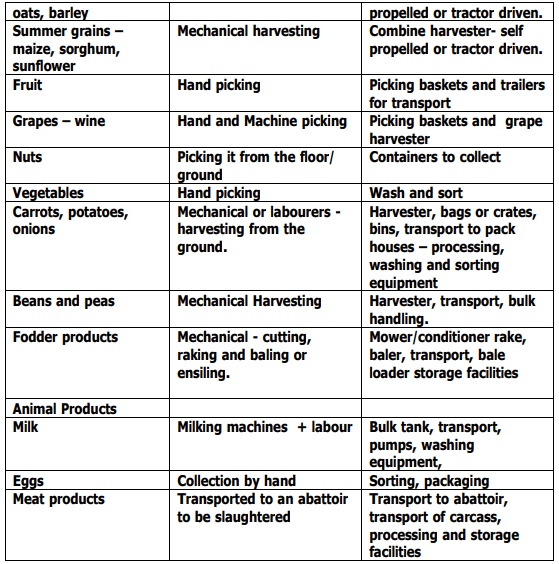Harvesting
Harvesting is the process of gathering matured products from the fields with the purpose of selling them or using them for their own consumption.
Harvesting marks the end of the growing season for that particular crop – maize, fruit, veggies, hay, etc. It is a very important time on the farming calendar as all time and energy are focused on removing the product from the field\orchard\land as fast as possible to ensure good quality produce and to prevent deterioration – especially fruit and veggies – by the time it reaches the market.
Criteria for Harvesting
Harvesting can only start when the crop or product is at the correct physiological stage – fruit must have the correct size, colour and sugar content whilst grain must be dry.
In the case of animals, “harvesting” of milk and eggs takes place on a daily basis. Products such as mohair, wool and feathers are “harvested” once or twice a year. Meat products are “harvested” when an animal is slaughtered.
Adjustments and Implementation
Various methods are used during the harvesting process:
![]()

The following factors will determine the equipment used for harvesting:
The type of product produced. Different equipment is used for different crops and products
The volume of a product to be harvested. Grain products –e.g., maize fields cover great areas – will mainly be mechanically harvested. Using expensive and sophisticated farm machinery such as combine harvesters saves time and will be more cost-effective.
The weather conditions. If the weather is not favourable for harvesting or only allow a short harvesting period, it will be worthwhile to make use of contractors or machinery to assist and get the harvest done in a short time as possible to ensure a quality product.
The market situation. Producers always aim for the highest or best price for their products. These prices are determined by ‘supply and demand’. It is therefore important for the producer to ‘read’ the market – he must either be early with his products or hold back (if possible) to supply in time of shortages. (The producer must at some stage get hold of extra labour or equipment to enable him\her to be early on the market.)
The level of intensification. The more intensive the farming operation, the more sophisticated the harvesting equipment will be to ensure that a product of very high quality is produced
The type of product. Fresh produce - at the correct physiological stage - must be harvested in a short time span and reach the market quickly to ensure good quality.
Evaluation of Harvesting Practices and Adjustments
The producer must evaluate the harvesting process to determine the following;
- Quality of the harvest – wastage, breaking of grain, damaging of the product.
- Speed or duration of the process
- Handling of the products
- Grading and sorting
- Alternative methods
- Quality of the product
Health and Hygiene Regulations and Legislation
Various crops and animal products are produced on farms. The quality of these products is regulated by regulations. This is necessary to protect the consumer and to ensure that the products meet the set standards.
The Directorate food safety and quality amend these regulations from time to time and it is their function to ensure that the regulations are applied and that the products comply with these regulations.
Products earmarked for export must also comply with a set of rules provided by the European Parliament. These strict regulations are applicable, not only to the hygiene of export products but to the facilities where the products were processed or produced as well. These regulations can also be obtained from the NDA website or from your local extension officer.

Product Evaluation Quality Control
It is the function of the farmer to supply the market with products that are clean, hygienic and of good quality. The quality of the product will determine the price and it will also lead to consumer satisfaction.
It is very important that the producer is aware of the consumer’s and market’s preferences. If products do not meet the requirements of the consumers, it will result in wastage – a loss in income! The same money, time, labour, etc. is needed to produce an inferior product vs. a quality product – the only difference will be the income on the market.
The farmer\management is thus forced by regulations – domestic and export - as well as the consumers to produce quality products.
Various processes of quality control should be in place to ensure the best quality products:
Production process – during the production process the manager, in his\her section, must enforce quality control at all times to ensure that the end product is not degraded due to machines not functioning well.
On-farm processing – during the processing on the farm quality control must be in place to ensure that only the best quality is processed and packed for the market.
At the farm gate – the last on-farm quality control should be at the last point to ensure the products are loaded correctly, handled correctly and that the transport will not affect the product.
Market control – The market agents are also obligated, to some extent, to do quality control before a product is sold. It is therefore important that the farmer communicates with the market agents to obtain information that can aid with the improvement of quality.
Local authorities (municipalities) appoint their own inspectors to ensure that products comply with regulations.
The Department of Health is responsible to ensure that hygiene at dairies, abattoirs and other processing facilities are adhered to. Facilities must be approved and certified on a regular basis. The Directorate Food Safety and other similar bodies are responsible for quality standards at supermarkets and other sales points.
Appointed agencies are responsible for the inspection and certifying of export products to ensure these meet and comply with the requirements of importing country.